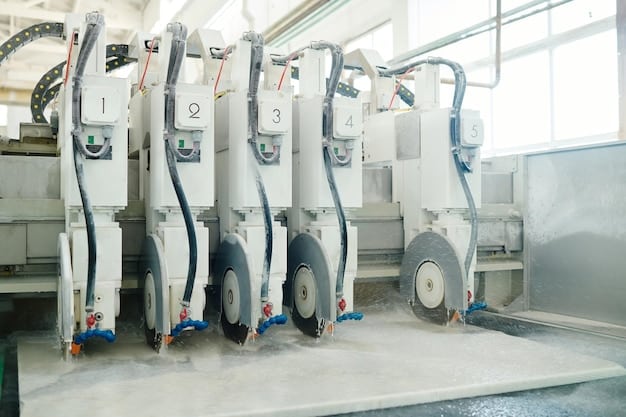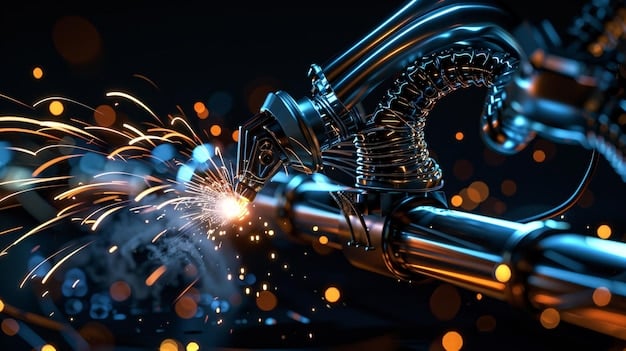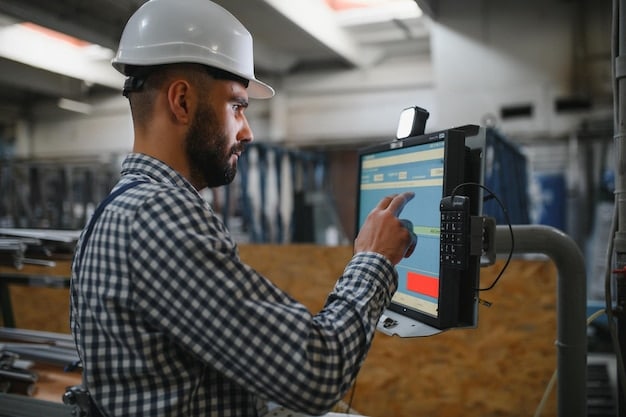Robotics and Automation: Essential Skills for Future Manufacturing

Robotics and automation are transforming manufacturing, demanding a workforce skilled in areas like robotics programming, AI integration, and mechatronics. These skills are crucial for driving efficiency and innovation in the future of manufacturing.
The manufacturing sector is undergoing a rapid transformation, driven by advancements in robotics and automation. To thrive in this evolving landscape, professionals need to acquire new skills and adapt to emerging technologies.
Are you ready to explore the key skills that will shape the future of manufacturing through robotics and automation?
Robotics and Automation: Revolutionizing Manufacturing
Robotics and automation are no longer futuristic concepts; they are integral parts of modern manufacturing. These technologies enhance productivity, improve quality, and reduce costs. Understanding how they work and how to leverage them is essential for anyone in the manufacturing sector.
The Impact of Robotics in Manufacturing
Robotics has significantly impacted manufacturing by:
- Automating repetitive tasks, freeing up human workers for more complex roles.
- Improving precision and consistency in production processes.
- Enhancing workplace safety by handling hazardous materials and tasks.
Companies that effectively integrate robotics into their operations gain a competitive edge by optimizing their production processes.
The Role of Automation Technologies
Automation technologies encompass a wide range of tools and systems, including:
- Programmable Logic Controllers (PLCs) that control machinery.
- Supervisory Control and Data Acquisition (SCADA) systems for monitoring and managing processes.
- Enterprise Resource Planning (ERP) systems that integrate various business functions.
Mastering these technologies enables manufacturers to streamline operations and make data-driven decisions.
In conclusion, robotics and automation play a pivotal role in modernizing manufacturing. Companies must invest in these technologies and develop a workforce capable of utilizing them effectively to stay competitive and innovate.

Essential Robotics Skills for Manufacturing Professionals
To succeed in the age of automation, manufacturing professionals need a specific set of robotics skills. These skills range from programming and maintenance to system integration and troubleshooting. Developing these competencies is crucial for optimizing manufacturing processes and driving innovation.
Robotics Programming and Software Skills
Proficiency in robotics programming languages such as:
- C++
- Python
- Java
Is essential for developing and customizing robotic applications. Additionally, understanding software tools like Robot Operating System (ROS) and simulation software is crucial for designing and testing robotic systems.
Robotics Maintenance and Troubleshooting
Maintaining and troubleshooting robots requires a combination of mechanical and electrical skills. This includes:
- Diagnosing and repairing mechanical issues.
- Troubleshooting electrical faults.
- Performing preventative maintenance to ensure optimal performance.
Professionals with these skills are vital for minimizing downtime and maximizing the lifespan of robotic systems.
Acquiring essential robotics skills is imperative for manufacturing professionals. By focusing on programming, maintenance, and system integration, individuals can enhance their value and contribute to the success of their organizations.
Automation Technologies and Advanced Manufacturing
Automation technologies are at the heart of advanced manufacturing, enabling companies to achieve unprecedented levels of efficiency and precision. Understanding these technologies and their applications is essential for driving innovation and staying ahead in today’s competitive landscape.
PLC Programming and Maintenance
Programmable Logic Controllers (PLCs) are the backbone of many automated systems. Skills in PLC programming and maintenance are crucial for:
- Designing and implementing control logic.
- Troubleshooting and repairing PLC-controlled systems.
- Optimizing PLC programs for enhanced performance.
Professionals with PLC expertise are highly sought after in modern manufacturing environments.
SCADA Systems and Data Analytics
Supervisory Control and Data Acquisition (SCADA) systems provide real-time monitoring and control of manufacturing processes. Analyzing SCADA data can provide valuable insights into process performance, enabling:
- Identifying bottlenecks and inefficiencies.
- Predicting equipment failures.
- Optimizing process parameters for improved quality and throughput.
Data analytics skills are essential for leveraging the full potential of SCADA systems.

By mastering PLC programming and leveraging SCADA systems for data analytics, manufacturing professionals can drive significant improvements in efficiency and performance. Continuous learning and adaptation are key to succeeding in advanced manufacturing.
Integrating AI and Machine Learning in Robotics and Automation
Artificial Intelligence (AI) and Machine Learning (ML) are transforming robotics and automation, enabling machines to learn, adapt, and make decisions autonomously. These technologies enhance the capabilities of robotic systems and create new opportunities for innovation in manufacturing.
AI-Powered Robotics
Integrating AI into robotics allows machines to perform tasks that were previously impossible. AI-powered robots can:
- Recognize objects and patterns.
- Navigate complex environments.
- Collaborate with human workers safely and effectively.
This integration enhances flexibility and adaptability in manufacturing processes.
Machine Learning for Predictive Maintenance
Machine learning algorithms can analyze data from sensors and equipment to predict when maintenance is needed. This predictive maintenance approach:
- Reduces downtime by addressing issues before they cause failures.
- Optimizes maintenance schedules.
- Extends the lifespan of equipment.
Predictive maintenance improves efficiency and reduces costs.
The integration of AI and machine learning in robotics and automation is revolutionizing manufacturing. Companies that embrace these technologies can achieve greater efficiency, flexibility, and innovation.
Developing a Skilled Workforce for Robotics and Automation
To fully leverage the potential of robotics and automation, manufacturers must invest in developing a skilled workforce. This includes providing training and education programs that equip workers with the knowledge and skills needed to operate and maintain advanced systems.
Training Programs for Robotics and Automation
Effective training programs should cover:
- Robotics programming and maintenance.
- PLC programming and troubleshooting.
- Data analytics and machine learning.
These programs should combine classroom instruction with hands-on experience to ensure workers develop practical skills.
Collaborations with Educational Institutions
Partnerships with universities and technical schools can help manufacturers access a pipeline of skilled workers. These collaborations can:
- Provide internship opportunities for students.
- Develop customized training programs.
- Conduct research to advance robotics and automation technologies.
These partnerships benefit both manufacturers and educational institutions.
Investing in workforce development is crucial for maximizing the benefits of robotics and automation. By providing training and fostering collaborations, manufacturers can ensure they have the talent needed to stay competitive and innovative.
The Future of Manufacturing: Robotics, Automation, and Beyond
The future of manufacturing will be shaped by continued advancements in robotics, automation, and related technologies. As these technologies evolve, they will create new opportunities for innovation and growth.
Emerging Trends in Robotics and Automation
Some emerging trends include:
- The use of collaborative robots (cobots) that can work alongside human workers safely.
- The integration of 5G technology for enhanced connectivity and real-time control.
- The development of autonomous mobile robots (AMRs) for flexible material handling.
Staying abreast of these trends is essential for manufacturers looking to innovate.
The Skills of the Future
In addition to technical skills, soft skills such as:
- Problem-solving.
- Critical thinking.
- Communication.
Will be increasingly important. Workers will need to be able to adapt to new technologies and collaborate effectively with both humans and machines.
The future of manufacturing is bright, with robotics and automation playing a central role. By embracing new technologies and developing a skilled workforce, manufacturers can unlock unprecedented levels of efficiency and innovation.
| Key Point | Brief Description |
|---|---|
| 🤖 Robotics Skills | Programming, maintenance, and system integration are crucial. |
| ⚙️ Automation Tech | PLCs and SCADA systems improve efficiency and data analysis. |
| 🧠 AI & ML | Enable predictive maintenance and autonomous decision-making. |
| 🎓 Workforce Training | Investing in training programs is key to skilled operations. |
Frequently Asked Questions
Key robotics skills include programming, maintenance, system integration, and troubleshooting. These skills are crucial for operating and maintaining robotic systems effectively.
Automation technologies like PLCs and SCADA systems enhance efficiency by streamlining processes, providing real-time monitoring, and enabling data-driven decision-making.
AI enables robots to perform complex tasks, recognize patterns, and collaborate with humans. It also facilitates predictive maintenance, reducing downtime and improving overall efficiency.
Manufacturers can develop a skilled workforce by investing in training programs, collaborating with educational institutions, and providing hands-on experience with advanced systems.
Emerging trends include collaborative robots, 5G technology, and autonomous mobile robots, enhancing flexibility and connectivity in manufacturing environments for robotics and automation.
Conclusion
The transformation of manufacturing through robotics and automation requires a focus on developing essential skills and integrating advanced technologies. By investing in training and staying abreast of emerging trends, manufacturers can unlock unprecedented levels of efficiency and innovation.
Embracing these changes will ensure manufacturers remain competitive and successful in the future.





